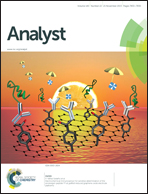Reporting a new siderophore based Ca2+ selective chemosensor that works as a staining agent in the live organism Artemia†
Abstract
A Ca2+-specific chemosensor involving acyclic non-ether and non-carboxylato-type metal chelating ligands is rare. The tetradentate OONO artificial receptor, HL, possessing a sulfur-containing intermediate siderophore aeruginic acid, tethered to a rhodamine 6G based signalling unit in a single molecule has been synthesized. The fluoroionophore required excitation in the visible wavelength (510 nm) and showed highly selective and sensitive detection of Ca2+ ions in 100% water solution in HEPES buffer at physiological pH (7.4). The probe HL, with LOD as low as 70 nM, behaves reversibly and showed nearly 17-fold enhanced selectivity for Ca2+ over other cell abundant alkali and alkaline metal ions such as Na+, K+, Li+, and Mg2+ without any intervention. Job's plot, 1H NMR titration and ESI-MS data provided corroborative evidence in support of 1 : 1 association between HL and Ca2+. From a wide range of transition and heavy metal ions series, HL also binds Cu2+. However, the use of L-cysteine removes the interference from Cu2+ and results in highly selective detection specificity of HL for Ca2+. As a reversible “off–on–off” fluorescent chemosensor, it is possible to detect Ca2+ at as low as 5 μM in the midgut region of the gastrointestinal tract of the live animal Artemia, a brine shrimp.


 Please wait while we load your content...
Please wait while we load your content...